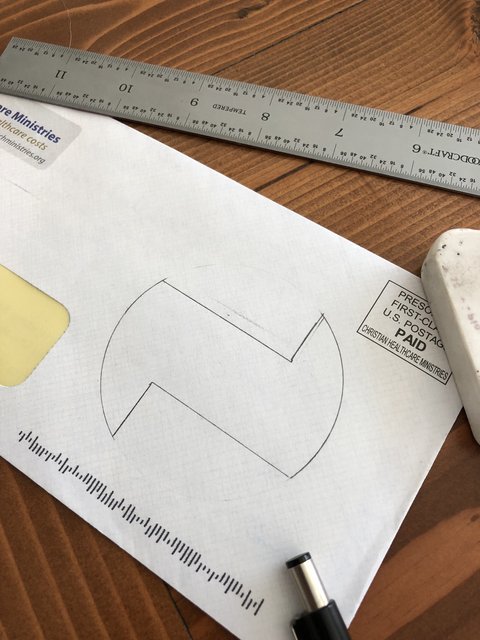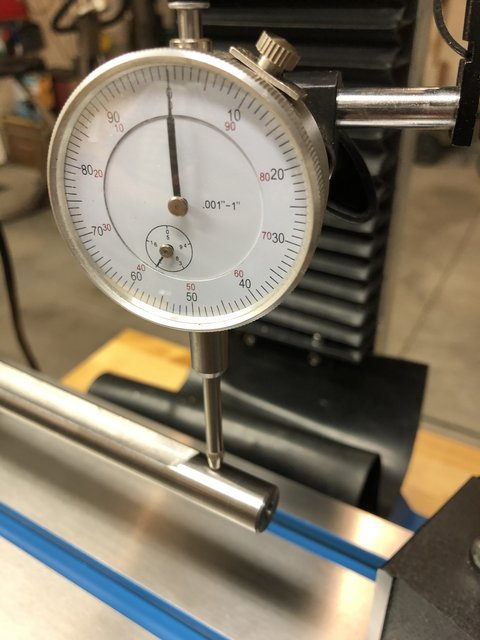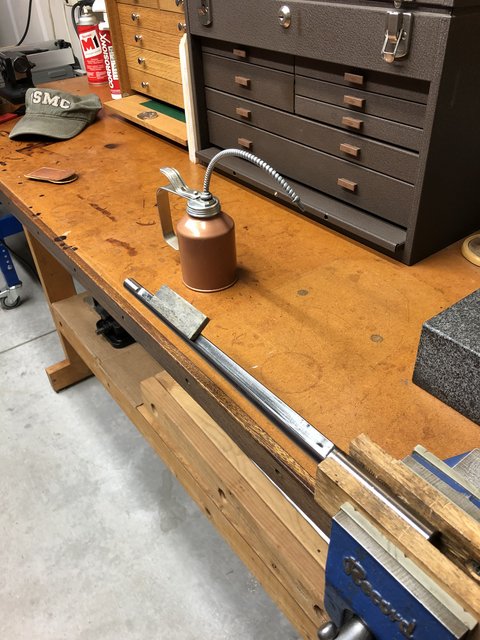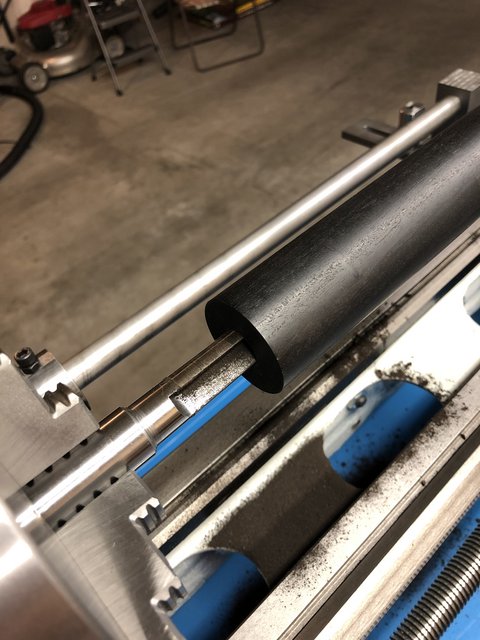Page 3 of 6
Re: My reamer-making saga
Posted: Mon Aug 31, 2020 2:46 pm
by William Bryant
paddler wrote:William, I think what may be happening is that your work-holding approach is bending the reamer.
Specifically, the center support, in order to provide sufficient lateral support, is being tightened to
the point that it pushes the center of the reamer upwards before the slot is cut. In your last picture
it is clear that there is no opposing force to prevent this bending. And since the resistance to lateral
movement in your approach is achieved only via friction between the brass plate and your mill table,
that central support must be pushing up quite hard on the center of the unsupported reamer blank.
Oh, and my milling machine is a Grizzly G0704.
My mill is a Weiss VM25L. Very similar I think.
Good guess about that central support. On that same assumption I milled another blank, same slot profile, without the central support, and the warp was just as bad. I don't think how I support things while cutting is the problem. It may help minimize chatter for a cleaner finish, but the warp (I believe after digging around a bit) is the result of internal stresses released in the cold-rolled steel rod itself cut to an asymmetrical profile.
I'm going to put an indexing head on my lathe this weekend, cut two opposing slots, and report back with results.

Re: My reamer-making saga
Posted: Mon Aug 31, 2020 3:01 pm
by paddler
When you milled a blank without using support, did it warp in the same direction?
It does not surprise me that milling with no central support can bend the blank too.
In fact, that is what I would expect, in addition to more chatter.
I use O1 tool steel for my reamers. I have not noticed any obvious warping, but it is
difficult to tell when the reamer profile is itself irregular. I suppose the best way to tell
is by cutting a bore with the new reamer and then profiling that bore to verify that it has
the same dimensions as the bore you are copying. If the bore that the warped reamer cuts
is still accurate, that would imply that there is enough flex in the reamer to straighten
itself out while reaming. But for short, fat, reamers this seems unlikely to me.
I suppose you could also try bending your warped reamers in order to straighten them again.
Re: My reamer-making saga
Posted: Mon Aug 31, 2020 3:13 pm
by William Bryant
paddler wrote:When you milled a blank without using support, did it warp in the same direction?
It does not surprise me that milling with no central support can bend the blank too.
In fact, that is what I would expect, in addition to more chatter.
I use O1 tool steel for my reamers. I have not noticed any obvious warping, but it is
difficult to tell when the reamer profile is itself irregular. I suppose the best way to tell
is by cutting a bore with the new reamer and then profiling that bore to verify that it has
the same dimensions as the bore you are copying. If the bore that the warped reamer cuts
is still accurate, that would imply that there is enough flex in the reamer to straighten
itself out while reaming. But for short, fat, reamers this seems unlikely to me.
I suppose you could also try bending your warped reamers in order to straighten them again.
Without the support it warped in the same direction and to the same degree. I really don't think it's a support issue. I've used 01, Stressproof, 1095, something unmarked off someone's shop floor.
It's easy to tell if my reamers have warped because they wobble noticeably and then measurably (as much as .100" TIR) when I slowly spin them.
Re: My reamer-making saga
Posted: Mon Aug 31, 2020 4:21 pm
by Geoffrey Ellis
William Bryant wrote:
It may help minimize chatter for a cleaner finish, but the warp (I believe after digging around a bit) is the result of internal stresses released in the cold-rolled steel rod itself cut to an asymmetrical profile.
My comparison of steel to wood (in the Flute Making Apprentices thread) was to illustrate this phenomena of tension. Untreated steel has tension, and the cold-roll seems particularly prone to it, which is why hardening is probably the only solution. That or you make a multi-blade reamer so there is no asymmetry.
Your sketch is a good approach (below is the drawing I made before I did my first two-bladed reamer). Like the 4-blade version, there was no warping. All of the D-profile reamers I've made have warped, but they have all been long and thin. I don't know if a shorter, thicker reamer that has warped will behave the same way or if you are more likely to get an eccentric cut...

Re: My reamer-making saga
Posted: Sat Sep 12, 2020 10:54 am
by William Bryant
The saga continues . . . (and bumped off the flute forum for some reason)
Here's a picture of my dividing head, set up on my mill. It's a little bit overkill, but it makes milling two opposing slots very easy. Using an ER32 collet holder also revealed that my lathe's three-jaw chuck is worse than I'd thought, off by .001" to .0015" in more than one axis. Kinda makes me want to get an MT4-ER32 holder for my lathe before turning flutes.

Re: My reamer-making saga
Posted: Sat Sep 12, 2020 11:01 am
by William Bryant
Here's the set up on the other end. Using an indicator I adjusted clamping pressure evenly and kept the reamer straight while milling.
(The lawn mower and pistol targets are seldom a significant part of my flute making saga. I said seldom, not never! Ha!)

Re: My reamer-making saga
Posted: Sat Sep 12, 2020 11:11 am
by William Bryant
The finished two-slot reamer (profile in earlier post) is about .005" TIR at the small end, not bad considering stacking tolerance errors from a three-jaw chuck, live center, taper jig, dividing head, and collet chuck. I wasn't happy with almost .100" TIR in the single-slot reamer. I think I can live with .005" in the two-slot reamer. (It still bugs me as a machinist, but I think it will work for its intended purpose.)

Re: My reamer-making saga
Posted: Sat Sep 12, 2020 11:52 am
by William Bryant
The slot profile I chose makes stoning the edges very easy, and the result very sharp.

Re: My reamer-making saga
Posted: Sat Sep 12, 2020 12:03 pm
by Dan A.
Quite a lot of work you have done there! While it's interesting to see what has gone into this project, I realize I lack so many essentials for making my own flute. Should I take up the flute, I'll have to have someone make one for me!
Re: My reamer-making saga
Posted: Sat Sep 12, 2020 12:54 pm
by William Bryant
Dan A. wrote:Quite a lot of work you have done there! While it's interesting to see what has gone into this project, I realize I lack so many essentials for making my own flute. Should I take up the flute, I'll have to have someone make one for me!
Maybe that will be me! What kind of flute would you like to play?
Re: My reamer-making saga
Posted: Sat Sep 12, 2020 4:34 pm
by Dan A.
William Bryant wrote:Maybe that will be me! What kind of flute would you like to play?
A traditional simple-system flute, but there's a bit of a catch: I'd play left-handed.
Re: My reamer-making saga
Posted: Tue Sep 15, 2020 6:32 pm
by William Bryant
It's been a long and tedious process, but I now have a set of reamers for making a flute. Will it work? Let's go back to the shop and find out.

Re: My reamer-making saga
Posted: Tue Sep 15, 2020 6:34 pm
by William Bryant
Success! My two-bladed design works!

Re: My reamer-making saga
Posted: Wed Sep 16, 2020 10:15 pm
by Geoffrey Ellis
Those look great! How is the cutting action on them? Nice, clean mill work as well (much more handsome that my own reamers turn out!).
Re: My reamer-making saga
Posted: Wed Sep 16, 2020 11:09 pm
by kkrell
There was an article:
On Reaming Flutes - Robert Bigio and Michael Wright - The Galpin Society Journal
May 2005.
Any use?
https://www.jstor.org/stable/25163825







